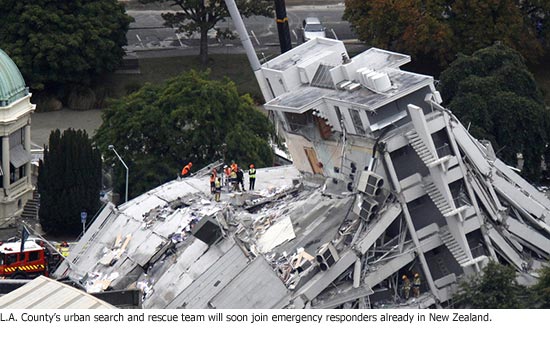Our rescuers Down Under
February 22, 2011
Los Angeles County’s disaster rescue-and-recovery team was mobilizing today to head to New Zealand, where a 6.3 magnitude earthquake crushed buildings and killed at least 65 people—a toll that is expected to rise as the search for the dead and injured continues around Christchurch.
The 74-member unit, known as “California Task Force 2,” was expected to leave at 2 a.m. Wednesday.
The team, made up of Los Angeles County firefighters, paramedics, emergency room doctors and other specialists, earned high marks for its work after the earthquake in Haiti. The urban search and rescue squad also has seen action in previous emergencies including Hurricane Katrina and the Oklahoma City bombing.
They’re traveling to New Zealand at the request of the U.S. Agency for
International Development and U.S. Office of Foreign Disaster Assistance, County Fire Chief Daryl Osby said in a letter to the Board of Supervisors.
“It is a source of great pride for our organization to not only have this highly specialized response capability, but to be called into duty by USAID to help save lives and property beyond our borders,” Osby said.
A fire department official is also heading to Washington, D.C., to help coordinate the team’s efforts in New Zealand.
The task force will be commanded by Battalion Chief Tom Ewald, a 19-year county fire department veteran who heads up county fire’s Battalion 3, serving East L.A., Bell and nearby communities. He worked as the team’s Pacoima-based deployment coordinator during the Haiti operation, and took part in disaster response operations after 9/11 and Hurricane Katrina.
When his day started Tuesday, Ewald had been preparing for another kind of trip. “I thought I was going home to get ready to take my family skiing,” Ewald said. “That all changed around 7 a.m.”
By early afternoon, the final arrangements were underway to transport staff and equipment to New Zealand. Ewald said the team will be ready to work as soon as they land.
“Once our equipment is off the aircraft, we can be operational within an hour,” Ewald said. “They have work sites already identified for us.”
It’s a high pressure assignment in a dangerous setting far from home. But for the Los Angeles County team, Ewald said, it’s nothing they haven’t seen before.
“It’s what we do as professional rescuers, day in and day out. We’re just plying our skills in somebody else’s backyard.”
Posted 2/22/11













 405 bridge work causes a stink
405 bridge work causes a stink
